Head Fake In Silver
A fall to a new low on November 14.
A rejection of the downside.
The trend continues to be lower.
$15.07 can change the trend.
USLV and DSLV for those who do not trade futures.
Silver has a long history as a volatile metal that moves more on a percentage basis than gold. Market speculators tend to flock to the silver market when it begins to develop a trend which typically starts with the break of technical resistance on the upside or support on the downside in the precious metal.
There are times when the silver market can offer incredible rewards. In 1978, the price blasted off from under $5 per ounce and reached a peak at over $50 in 1980. Silver turned around and fell below $10 in 1981.
In 2008, the price began a climb from under $10 that took it to $49.82 in 2011. The peak provided an opportunity for a significant bearish trend to develop that brought the price to less than half that level by 2013. These days with the price sitting at $14.49 as of Wednesday, November 21, silver has been in a range between just under $14 and $15 per ounce. The most recent attempt to break below its level of critical support failed last week.
Silver has been frustrating bulls and bears throughout 2018, as looking for a break to the up or downside has been a losing proposition for traders and investors. Silver has been a market where head-fake moves have become the norm rather than the exception. The most direct route when it comes to taking advantage of silver's refusal to break out of its trading range is via buying dips and selling rallies in the COMEX silver futures market. For those who do not venture into the futures arena, the Velocity Shares 3X Long Silver ETN product (USLV) and its bearish counterpart (DSLV) offer leveraged alternatives that are suited for short-term forays into the silver market on the long and short side.
A fall to a new low on November 14
The dollar index made a higher high on November 12 at 97.53 and gold slipped below the $1200 level. Silver, the volatile precious metal overreacted and fell to a new low on November 14 that was the lowest price since mid-January 2016 at $13.86 per ounce. 
Source: CQG
As the weekly chart highlights, at under $14 per ounce, silver continued to flirt with its level of critical technical support that stands at the December 2015 bottom at $13.635. Last week was the fourth time since September that silver probed below the $14 level, and at $13.86 it put in a new and lower bottom that was only 22.5 cents from what could be a line in the sand for the price of the precious metal. A break below the 2015 bottom could cause a tsunami of stop-loss and trend-following selling in the silver market.
A rejection of the downside
While November 14 started as a scary day for the silver bulls, it wound up being a very good day for the market as the price rejected trading below the $14 per ounce level. 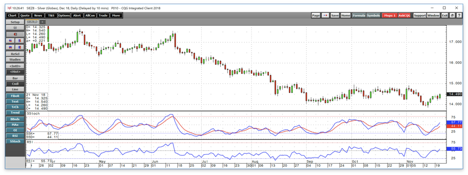
Source: CQG
As the daily chart illustrates, silver put in a bullish key reversal trading pattern on November 14. After falling to a new low, it closed just one-half of one cent higher than the prior day's close. Both price momentum and relative strength turned higher in oversold territory, and the price of silver moved back to the $14.49 level, in the middle of its $14-15 trading range.
Meanwhile, the longer-term picture for the silver market continues to point to lower prices for the precious metal.
The trend continues to be lower
Silver has been in a bear market since July 2016 when the price hit a high of $21.095 in the aftermath of the Brexit referendum. 
Source: CQG
The monthly chart shows that the move to $13.86 was another in a long series of lower lows for the silver market. While price momentum and relative strength continue to point lower, both technical metrics have dropped into oversold territory. Open interest, the total number of open long and short positions in the silver futures market, has been rising as the price has moved to the downside. Increasing open interest and price depreciation tend to be a technical validation of a bearish trend in a futures market. At the same time, monthly historical volatility has declined to 10.73%. In 2018, the metric that measures price variance has been at its lowest level since early 2001. The move to the downside in the silver market has been slow and steady.
$15.07 can change the trend
To break the pattern of lower highs and lower highs in the silver market, the price needs to move above the $15 per ounce level. 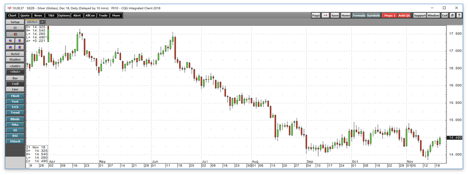
Source: CQG
The daily chart shows that the most recent move to the downside in the silver market began at the $14.92 high on November 2. On October 2, silver made it to a peak of $14.95. The last time the precious metal traded above the $15 level was on August 28 when the price found a top at $15.07 which stands as the critical resistance level. A move above $15.07 could launch a period of short-covering and launch trend-following buying in the market. Silver is a market that moves higher or lower on sentiment. Supply and demand fundamentals for silver can be meaningless as the metal is a byproduct of other metal production. Production cost in the silver market tends to have less input into its path of least resistance than in other commodities. In the silver market, it is investment demand that drives the price over time. A break above $15.07 could change sentiment and bring buying back to the metal.
Another sign of silver's weakness has been its price relationship with gold.
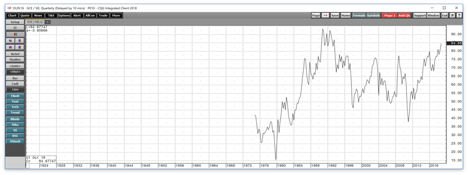
Source: CQG
As the quarterly chart of nearby gold divided by silver futures on COMEX shows, the current price levels indicate that silver is at its lowest level versus the yellow metal in two and one-half decades, since 1993. A move above $15.07 and a turn lower in the silver-gold ratio to support a return of upside volatility to the silver market, which continues to suffer from a lack of buying these days.
USLV and DSLV for those who do not trade futures
Silver is a metal that tends to make a significant move on the up or downside when the market is most comfortable and ignores the price action. Silver can hibernate for extended periods, but it always seems to make a move that catches the vast majority of market participants sleeping.
As silver probes below the $14 per ounce level, it comes close to a challenge of critical technical support. So far, those moves to the downside have ended with a rejection as the market has run out of the selling necessary to push the price to a new multiyear low. The consistent rejections of the downside could be setting the stage for a surprise rally in the silver market sooner, rather than later. The metal that tends to make more than a few head fake moves could be creating an environment where the most significant surprise could turn out to be a rally that takes the price above resistance while the market concentrates on support.
The most direct route for a trade or investment in the silver market is via the bars and coins in the physical market or the futures and options that trade on the COMEX division of the CME. With historical volatility at the lowest level in almost two decades, option premiums are at very low levels these days and offer value and could be a wise choice from a risk-reward perspective. When you purchase a call or a put option, the only risk is the premium for the instrument.
For those who do not trade in the futures arena, USLV and its bearish counterpart DSLV provide alternatives on the long and short sides of the market. The fund summary for USLV states:
The investment seeks to replicate, net of expenses, three times the S&P GSCI Silver index ER. The index comprises futures contracts on a single commodity. The fluctuations in the values of it are intended generally to correlate with changes in the price of silver in global markets.
USLV uses leveraged positions in the silver derivatives market to create triple leverage on the long side of the silver market while the inverse DSLV does the same on the short side. Both products suffer from time decay which is the price for the leverage making them susceptible to reverse splits that destroy the value of the tools. Therefore, they are only appropriate for short-term positions in the silver market. Silver moved from a low of $13.86 on November 14 to a high of $14.54 on November 21 or 4.9% higher. 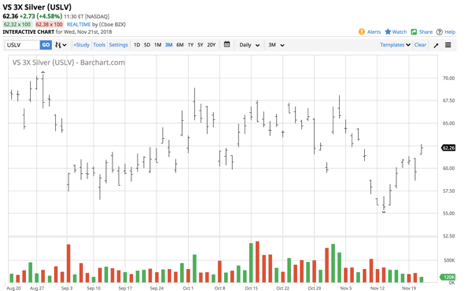
Source: Barchart
As the chart shows, USLV moved from $55.31 to $62.67 over the same period, a rise of 13.3%, just under a triple return compared to the futures market.
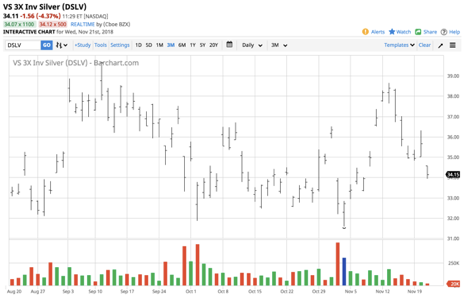
Source: Barchart
DSLV dropped from $38.65 to $33.93 as silver rejected the November 14 low, a drop of 12.2% recently.
USLV and DSLV are useful tools for market participants looking for turbocharged positions in the silver market without the need to dip a toe into the futures market. These days, I believe that anyone looking for a break to the up or downside in the silver market should look at options on futures as they provide the most attractive risk-reward proposition with volatility at its lowest level in many years.
Silver loves to make moves that turn out to be head fakes. It would be ironic if the four attempts to crack below $14 and under the December 2015 low gave way to a rally that took the price of silver above technical resistance. Silver was sitting at the middle of its trading range as of November 21. I favor the upside in the silver market, and call options at strike prices at $15 and above could be the best way to limit risk and stay in the game when the price action is in head fake mode.
The Hecht Commodity Report is one of the most comprehensive commodities reports available today from the #2 ranked author in both commodities and precious metals. My weekly report covers the market movements of 20 different commodities and provides bullish, bearish and neutral calls; directional trading recommendations, and actionable ideas for traders. More than 120 subscribers are deriving real value from the Hecht Commodity Report.
Disclosure: I/we have no positions in any stocks mentioned, and no plans to initiate any positions within the next 72 hours.
I wrote this article myself, and it expresses my own opinions. I am not receiving compensation for it (other than from Seeking Alpha). I have no business relationship with any company whose stock is mentioned in this article.
Additional disclosure: The author always has positions in commodities markets in futures, options, ETF/ETN products, and commodity equities. These long and short positions tend to change on an intraday basis.
Follow Andrew Hecht and get email alerts